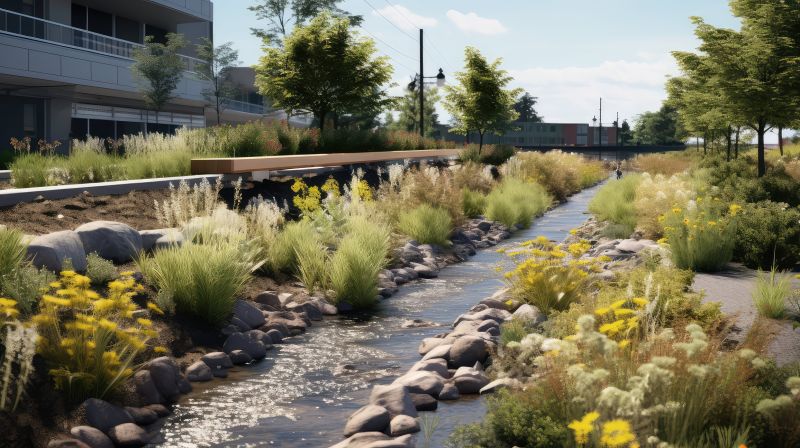Top Choices For Drainage Swale Installation Products For Seamless Water Flow
Identify the most effective tools and materials to help you achieve a well-functioning drainage system with minimal effort.
 Drainage swale installations are essential for managing excess water runoff and preventing erosion in various landscape settings. Properly designed and equipped swales can direct water flow efficiently, reducing pooling and potential damage to property structures. When selecting products for a drainage swale, it is important to consider durability, permeability, and ease of installation to ensure long-term effectiveness.
Drainage swale installations are essential for managing excess water runoff and preventing erosion in various landscape settings. Properly designed and equipped swales can direct water flow efficiently, reducing pooling and potential damage to property structures. When selecting products for a drainage swale, it is important to consider durability, permeability, and ease of installation to ensure long-term effectiveness.
Top Overall Option
Flexible Geotextile Drainage Fabric
This versatile drainage fabric is designed to provide filtration and separation in swale installations. Its durable, permeable material helps prevent soil erosion while allowing water to pass through efficiently. Easy to install and suitable for various soil types, it supports long-term performance in drainage projects.
Types of Products For Drainage Swale Installations
Perforated Drainage Pipe
Flexible pipes with perforations to facilitate water flow within the swale, often used with gravel or stone bedding for optimal drainage.
Erosion Control Blanket
Protects soil from erosion during and after installation, promoting vegetation growth and stability.
Geotextile Fabric
Provides filtration and separation for soil and aggregate layers, preventing clogging and soil migration.
Gravel and Drain Rock
Aggregates used to fill trenches and around pipes to improve water movement and stability.
Outlet Structures
Designed to direct water outflow safely, these structures help control discharge points and prevent erosion.
Flexible Corrugated Pipe
Durable piping option that adapts to various trench shapes and sizes for effective drainage.
Erosion Control Matting
Matting material that stabilizes slopes and reduces soil displacement during heavy water flow.
Filter Socks
Fabric tubes filled with gravel or other media, used to filter water and prevent sediment runoff.
Outlet End Caps
Seals pipe ends to prevent debris entry and control water flow at discharge points.
Drainage Inlet Covers
Covers designed to prevent debris from clogging drainage pipes and outlets.
Stormwater Management Gates
Valves or gates that regulate water flow within the swale for better control.
Silt Fences
Barrier fences that trap sediment and prevent it from entering drainage systems.
Flexible Pipe Connectors
Connectors that facilitate joining different pipe sections and ensuring a secure fit.
Drainage Basin Inserts
Components that help collect and direct runoff into the swale system.
Water Flow Meters
Devices used to monitor and measure water flow within the drainage system for maintenance purposes.
Popular Choices
Widely used for its flexibility and ease of installation in swale systems.
Commonly selected for effective water collection and conveyance.
Popular for its filtration properties and soil separation capabilities.
Frequently used as bedding material to improve drainage around pipes.
Chosen to stabilize slopes and prevent soil loss during heavy water flow.
Often selected for directing water safely away from the swale area.
Popular for sediment filtration and runoff containment.
Effective for capturing runoff and directing it into the system.
Used to control water flow and prevent overflow.
Commonly installed to trap sediment and prevent clogging.
Popular for sealing pipe ends and controlling discharge.
Chosen for its adaptability to various trench shapes.
A well-constructed drainage swale often incorporates a combination of materials that work together to facilitate water movement while maintaining soil stability. Typically, this involves the use of specialized liners, geotextiles, and outlet structures that help control flow rate and prevent soil erosion. These components should be chosen based on site-specific conditions, including soil type, slope, and expected water volume.
Installation products also include a variety of pipe options, gravel or stone aggregates, and erosion control fabrics. These products are designed to work in tandem, providing a comprehensive solution that can be adapted to different landscape needs. Proper selection and installation of these materials can significantly improve the performance of a drainage swale, ensuring it functions as intended over time.
Understanding the key features of each product type and their compatibility with existing landscape elements can help in creating an effective drainage system. Whether for a small residential yard or a larger commercial site, choosing the right combination of products is vital for optimal water management. Consulting product specifications and installation guidelines can aid in making informed decisions that match specific project requirements.
Key Buying Considerations
- Assess the volume of water runoff expected to determine pipe diameter and capacity.
- Consider soil type and permeability to select appropriate filtration and drainage materials.
- Evaluate slope and terrain to choose suitable pipe and outlet configurations.
- Check for compatibility of materials with existing landscape features.
- Determine the longevity and durability of products based on installation environment.
- Review installation requirements and ease of handling, especially for larger projects.
- Ensure products meet relevant standards for drainage and erosion control.
- Plan for future maintenance access and ease of cleaning or repairs.
- Consider the size and spacing of outlet structures for effective water dispersal.
- Evaluate the need for additional erosion control measures like mats or blankets.
- Account for local regulations or guidelines related to stormwater management.
- Choose products that facilitate proper water flow without causing backups or flooding.
- Think about the aesthetic integration with the surrounding landscape.
- Budget for both initial installation and ongoing maintenance costs.
- Consult with professionals or suppliers to match products with specific site conditions.
